|
工程
Process |
作業内容
Hows |
写真とコメント
Photos and coments |
| 1 |
藤切り
Cutting off the vines of wisteria |
5から10年もので親指の太さのつるを刈る。右回り(上から見て)に巻いている野田フジを刈るべし。水分をよく吸っている5月ごろがベスト。
The vines must be about 5~6years old and they must be as thick as your
thumb. Nodafuji which is good for the purpose winds clockwise (seeing from
the top).The best season is in May when the plant contains much water.
|
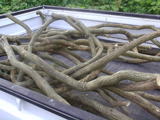 藤を見分ける決め手は樹皮の横しわ。ゾウさんの皮膚のようです。木質化した葛や他のつる植物でそっくりなものがあるのでご用心。 藤を見分ける決め手は樹皮の横しわ。ゾウさんの皮膚のようです。木質化した葛や他のつる植物でそっくりなものがあるのでご用心。
There are some other vines which resemble wisteria,like old kuzu. Wisteria
has horizontal lines on its bark which look like elephant's skin. |
| 2 |
藤剥ぎ
Stripping off the outer bark. |
木槌で叩き、樹皮を木質部から分離させる。さらに外皮(鬼皮)を取り除き、中皮(アラソ)だけにする。
By beating the vine of wisteria with a wooden mallet, the bark is stripped
off the core. Then separate the inner bark from the outer one. |
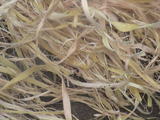 結構力が要る作業。ねじれているものや太すぎるものは剥ぎにくい!藤でない植物はこの段階でわかる。 結構力が要る作業。ねじれているものや太すぎるものは剥ぎにくい!藤でない植物はこの段階でわかる。
This process needs physcal strength. The wrong choices in the previous
process are to be found: twisted ones,too thick ones,other kind of vines,and
so on. |
| 3 |
灰汁炊き
Boiling with ash lye |
中皮を木灰でよくもんで約2時間炊く。上下をひっくり返してさらに2時間ほど。
The inner bark is boiled with ash lye from trees for about two hours. After
that it is turned upside down and continue to be boiled two more hours
. |
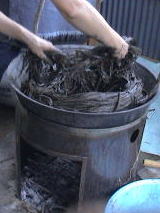 現代生活では良質の木灰を入手するのが最大の困難。私は炭酸カリウムを加えることもあります。 現代生活では良質の木灰を入手するのが最大の困難。私は炭酸カリウムを加えることもあります。
Getting ash lye is difficult
in our modern life.so sometimes potassium carbonate is added when you do
not have enough ash. |
| 4 |
藤こき
Scraping the boiled bark |
炊き上がったものを流水できれいに洗い、コウバシという竹の小さな道具で不純物をこき落とす。
Non-fibrous part of the boiled inner bark is scraped off in a stream, using
a small tool made of bamboo. |
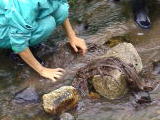 きれいな小川があればベストなんだけど…。家ではホースで流水を作ってやってます。 きれいな小川があればベストなんだけど…。家ではホースで流水を作ってやってます。
The best way is in a stream or in a shallow river. But we can do it with
tap water making artificial stream with a hose. |
| 5 |
のし入れ
Soaking the fiber in the rice bran.
|
糠を湯に溶いて繊維によく揉みこむ。繊維を絞り、糠をはたき落として干す。
The fiber is soaked into hot water with rice bran and rubbed.Then the fiber
is squeezed and beaten so that bran drop off.
After that the fiber is hung to be dried. |
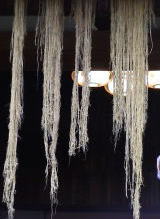 なぜ糠を?と思われたら糠なしでやってみたらよろしい。繊維同士がばりばりにくっついてしまいます。また、漂白効果、リンス効果があるとも言われています。 なぜ糠を?と思われたら糠なしでやってみたらよろしい。繊維同士がばりばりにくっついてしまいます。また、漂白効果、リンス効果があるとも言われています。
If you wonder why the bran is necessary try without it. The fibers will
be sticked to each other.Besides it is said that the bran neutralizes and
bleaches the fiber. |
| 6 |
藤績み
Ply-joining fibers.
|
繊維同士を撚りつないでいく。
Two fibers are plyed and joined to be a long yarn. |
最も根気の要る作業。ベテランのおばあさんでも一反分績むのに1ヶ月かかると言います。
(績むってなあに?→)
This process needs a lot of patience.It takes about one month even for
a skilled old woman to make yarns for a kimono.
(What is ply-joining ?→) |
| 7 |
撚りかけ
Twisting the yarn. |
湯に浸けた糸によりを掛ける。
The string is dipped in hot water and is twisted. |
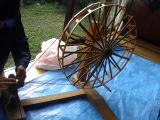 こんな撚りかけ機を使います。 こんな撚りかけ機を使います。
This kind of wheel is used. |
| 8 |
枠取り
Winding the yarn on a frame. |
撚られた糸を大きな木枠に巻き取る。
The twisted yarn is wound on a large wooden frames. |
この工程は、できた糸の長さを測る意味もあります。
In this process we can also know the length of the yarn. |
| 9 |
経バタ
Warping |
繊維の方向性を一定にするため、輪状整経します。
Warping must be done in one direction so as to keep the natural directional
properties of the fibers.
|
藤の刈り取りから織り上がるまで、常に繊維の流れが植物の「根元」から「先」へ流れるように計算されている。
Through all the processe the directional properties of the plant are considered
to be kept in one way: from the base to the tip. |
| 10 |
機にオワセル
Setting the warp yarn on the loom. |
機に整経した糸を仕掛けます。
The warp yarn is set on the loom. |
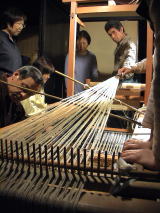 |
| 11 |
機織り
Weaving
|
やっとのことでトンカラリ!
At last we can weave.
|
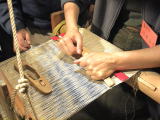 経糸には糊をつけながら、緯糸は常に湿らしながら織ります。 経糸には糊をつけながら、緯糸は常に湿らしながら織ります。
The warp must be glued and the weft must be moistened during the weaving
process. |
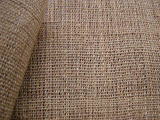 昔は藤で布を織ることはかなりの地域で行われていたそうです。その技術を保存しようと20年間活動してきたのが京都府にある上世谷集落の「丹後藤織り保存会」。この地域では藤布を「のの」と呼んでいたそうです。皆さんの周りにもあるはず。花だけ愛でて、あとは他の木に絡み付く雑草扱い、なんてもったいない!
昔は藤で布を織ることはかなりの地域で行われていたそうです。その技術を保存しようと20年間活動してきたのが京都府にある上世谷集落の「丹後藤織り保存会」。この地域では藤布を「のの」と呼んでいたそうです。皆さんの周りにもあるはず。花だけ愛でて、あとは他の木に絡み付く雑草扱い、なんてもったいない! 藤を見分ける決め手は樹皮の横しわ。ゾウさんの皮膚のようです。木質化した葛や他のつる植物でそっくりなものがあるのでご用心。
藤を見分ける決め手は樹皮の横しわ。ゾウさんの皮膚のようです。木質化した葛や他のつる植物でそっくりなものがあるのでご用心。 結構力が要る作業。ねじれているものや太すぎるものは剥ぎにくい!藤でない植物はこの段階でわかる。
結構力が要る作業。ねじれているものや太すぎるものは剥ぎにくい!藤でない植物はこの段階でわかる。 現代生活では良質の木灰を入手するのが最大の困難。私は炭酸カリウムを加えることもあります。
現代生活では良質の木灰を入手するのが最大の困難。私は炭酸カリウムを加えることもあります。 きれいな小川があればベストなんだけど…。家ではホースで流水を作ってやってます。
きれいな小川があればベストなんだけど…。家ではホースで流水を作ってやってます。 なぜ糠を?と思われたら糠なしでやってみたらよろしい。繊維同士がばりばりにくっついてしまいます。また、漂白効果、リンス効果があるとも言われています。
なぜ糠を?と思われたら糠なしでやってみたらよろしい。繊維同士がばりばりにくっついてしまいます。また、漂白効果、リンス効果があるとも言われています。 こんな撚りかけ機を使います。
こんな撚りかけ機を使います。
 経糸には糊をつけながら、緯糸は常に湿らしながら織ります。
経糸には糊をつけながら、緯糸は常に湿らしながら織ります。